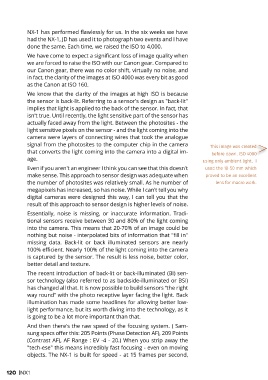Page 120 - NyghtVision Magazine Volume 5 #2
P. 120
NX-1 has performed flawlessly for us. In the six weeks we have This image was created
had the NX-1, JD has used it to photograph two events and I have before dawn. ISO 4000
done the same. Each time, we raised the ISO to 4,000. using only ambient light. I
used the 18-50 mm which
We have come to expect a significant loss of image quality when proved to be an excellent
we are forced to raise the ISO with our Canon gear. Compared to
our Canon gear, there was no color shift, virtually no noise, and lens for macro work.
in fact, the clarity of the images at ISO 4000 was every bit as good
as the Canon at ISO 160.
We know that the clarity of the images at high ISO is because
the sensor is back-lit. Referring to a sensor's design as "back-lit"
implies that light is applied to the back of the sensor. In fact, that
isn't true. Until recently, the light sensitive part of the sensor has
actually faced away from the light. Between the photosites - the
light sensitive pixels on the sensor - and the light coming into the
camera were layers of connecting wires that took the analogue
signal from the photosites to the computer chip in the camera
that converts the light coming into the camera into a digital im-
age.
Even if you aren't an engineer I think you can see that this doesn't
make sense. This approach to sensor design was adequate when
the number of photosites was relatively small. As he number of
megapixels has increased, so has noise. While I can't tell you why
digital cameras were designed this way, I can tell you that the
result of this approach to sensor design is higher levels of noise.
Essentially, noise is missing, or inaccurate information. Tradi-
tional sensors receive between 30 and 80% of the light coming
into the camera. This means that 20-70% of an image could be
nothing but noise - interpolated bits of information that "fill in"
missing data. Back-lit or back illuminated sensors are nearly
100% efficient. Nearly 100% of the light coming into the camera
is captured by the sensor. The result is less noise, better color,
better detail and texture.
The recent introduction of back-lit or back-illuminated (BI) sen-
sor technology (also referred to as backside-illuminated or BSI)
has changed all that. It is now possible to build sensors “the right
way round” with the photo receptive layer facing the light. Back
illumination has made some headlines for allowing better low-
light performance, but its worth diving into the technology, as it
is going to be a lot more important than that.
And then there's the raw speed of the focusing system. ( Sam-
sung specs offer this: 205 Points (Phase Detection AF), 209 Points
(Contrast AF), AF Range : EV -4 - 20.) When you strip away the
"tech-ese" this means incredibly fast focusing - even on moving
objects. The NX-1 is built for speed - at 15 frames per second,
120 |NX1

